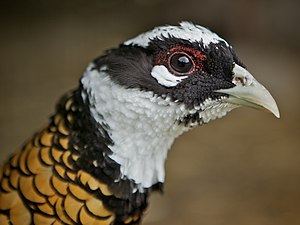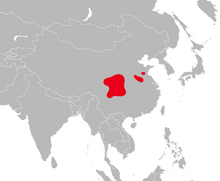King Pheasant
| King Pheasant | ||||||||||
|---|---|---|---|---|---|---|---|---|---|---|

Head portrait of a male king pheasant |
||||||||||
| Systematics | ||||||||||
|
||||||||||
| Scientific name | ||||||||||
| Syrmaticus reevesii | ||||||||||
| ( Gray , 1829) |
The king pheasant ( Syrmaticus reevesii ) is a species of bird from the pheasant family. It is particularly noticeable for its unusually long tail, which in the male can be between 1 and 1.40 meters long.
The king pheasant is native to parts of central and eastern China , where it inhabits forested mountainous areas. It is threatened there due to its limited range and the increasing destruction of its habitats and is classified as "endangered" by the IUCN .
Since the species is not very sensitive to climatic conditions, it is often kept in captivity. Naturalization attempts in Europe and the USA mostly failed in the long run, but there are currently free-living populations in Hawaii, France and the Czech Republic, for example.
The specific epithet honors the English naturalist John Reeves , who brought the first living rooster of this species to Europe in 1831.
description
Because of the extraordinary length of the tail of 100–140 cm, the male can reach a total length of up to 210 cm. The wing length is between 262 and 272 mm and the weight is around 1500 g. With a length of 75 cm, of which the tail accounts for about 36-45 cm, the female is smaller and lighter with about 950 g. The wing length is between 235 and 250 mm.
The sexes also differ significantly in the plumage color. In the male, the head is unmistakably drawn in black and white with a black face mask that extends to the upper neck. The parting, chin, throat and center of the neck are white. The lower, white half of the face is bordered by a black band towards the neck. There is also a white feathered field under the eye, which is lined above the upper edge or just behind it by a narrow, featherless, and strawberry-red section. The lower neck, back, rump, shoulders and sides of the chest are intense and golden cinnamon brown, the rounded feathers are lined with black, which creates a scale-like pattern and the hems become wider towards the center of the back. In addition, these feathers are black at the base. The wing covers look black and white, the white feathers have wide, black borders and a black base. This pattern continues on the front chest and the upper flanks, but here the feathers show maroon hems or a maroon subterminal band with a black end hem. Towards the rear flanks, the feathers are increasingly banded in black and white in the center; they become yellow-brown towards the hem and have red-brown tips or end hems. The center of the abdomen, legs and under tail covers are black. The wings of the hand are dark brown with red-brown transverse spots and cream-colored spots on the outer flag. The arm wings show white cross bars on a black-brown background and a yellow-brown border on the inner flag, which becomes lighter towards the umbrella feathers. The extremely elongated control feathers are white-gray with a light yellow-brown hem and a cross band that becomes black in the middle of the feather and becomes narrower and maroon towards the hem. The short, outer tail feathers are cinnamon-brown with a black tip and similar spots on the inner vane. The feet are horn-colored, the beak greenish gray-white, the iris red.
The female is more inconspicuously colored. The cinnamon-colored head markings are somewhat reminiscent of partridge or quail . It includes the forehead, the stripe above the eyes, the reins, an area under the eye, the chin, the throat and the upper neck. The parting is black-brown with reddish seams as well as a field in the neck, ear covers and a narrow crescent-shaped stripe under the eye are black. The chest is covered with red-brown feathers, which have light brownish-gray shaft stripes that widen to form an extended end band. The middle of the belly is beige and the same color is mixed with broad red-brown feathers on the flanks. The feathers of the lower neck are dark red-brown with a black end, except for the upper back, and have white, arrow-shaped shaft spots. The back and rump show gray-brown wavy feathers with rust-yellow hems and black spots on the shaft. Shoulder plumage, arm covers and wings bear black spots and long, narrow, rusty yellow spots on the shaft. The upper wing-coverts show a more reddish brown, less black and yellowish-brown end borders. The wings of the hand are banded reddish-yellow-brown on the outside flags on a dark brown background and red-brown on the inside flags. The inner control feathers are pale gray-brown with a fine drawing that becomes blackish towards the shaft and shows light cross bars. The outer ones are red-brown with a dark brown-white banding of the inner lugs and white tips.
The youth dress is similar to that of the female, but it lacks the reddish brown of the neck and, in addition, the throat, sides of the head and underside are white, the wings are spotted yellow. In the first autumn the young birds molt into old age.
Distribution and existence
The king pheasant is endemic to parts of central and northeastern China. The range of the monotypic species is very fragmented today. It covers a large part of central and eastern Sichuan , extends north to the extreme south of Gansu and southwestern Shaanxi , east to western Hubei , the extreme west of Hunan and south to the northern half of Guizhou and northeast Yunnan . Another occurrence extends from central and eastern Henan to northwest and central Anhui . There are also apparently local deposits in Shanxi , Hebei and possibly in Jiangsu . The area has probably halved compared to the original expansion, which extended from southwest Manchuria at around 40 ° N south to around 30 ° N as far as the Yangtze in Sichuan.
While the species was previously described as common, it can now only be found scattered. Mainly due to extensive deforestation, it is in decline, the distribution area is very fragmented. The population is currently estimated at 2,500 to a maximum of 10,000 individuals. Other sources of danger are illegal hunting and the collecting of eggs. In the past, the species was also hunted to use the magnificent feathers for the costumes of the Peking Opera . With the increasing use of artificial feathers, this threat is likely to be low.
Since the second half of the 19th century, various naturalization attempts have been made in Europe and the USA, especially for hunters and sport shooters. Larger wild populations currently exist in Hawaii, France and the Czech Republic. Occurrences in Great Britain are believed to be extinct. Although the species is insensitive to cool climates and bad weather and also breeds in the wild, most populations cannot sustain themselves in the long term if they are not kept alive by releasing more animals. The species keeps best in northern and central France, where it has developed self-sustaining populations for at least ten years in various large forest areas. At the end of the 1990s, the population there was estimated to be between 1,000 and 1,500 breeding pairs. In the Czech Republic, the largest populations are in North and Central Moravia , where there are also large pheasantries, from which the population there, which at the end of the 1990s comprised around 200–400 birds, is likely to be strongly supported by releases or captive refugees. Other, small occurrences are known from Hungary, Austria and Germany.
habitat
The king pheasant breeds in mountain forests in the transition between the temperate and subtropical zones and occurs mainly at altitudes between 550 and 1800 m. It is also rarely found in valleys or gorges in lower elevations. He prefers deciduous forests with a lot of oak trees, which have a dense canopy and little undergrowth. But coniferous forests and bushland are also accepted. On the edge of the cultural landscape, the species also uses fields for foraging.
Way of life
The roosters of the polygynous king pheasant occupy a territory with usually one or two hens from spring. The courtship includes a characteristic, widely audible whirring of wings as well as a series of calls of 6–20 whistles with a melodic trill at the end. The male then mates around a female in narrowing circles, stands up to the side, ruffles the plumage in an inclined position with open wings and the tail pointing towards the female, and hops towards the female. Shortly before it, the head is bent on the back and the tail is raised.
The clutch consists of 7-15 yellowish to beige eggs, which are about 46 x 37 mm in size and are incubated for 24 to 25 days.
In autumn, smaller societies come together for the winter, which dissolve again in spring. In autumn and winter, the diet consists of acorns, rose hips and the fruits of dwarf medlar .
literature
- Heinz-Sigurd Raethel : Chicken birds of the world. Verlag J. Neumann-Neudamm GmbH & Co. KG, Melsungen 1988, ISBN 3-7888-0440-8 .
- Karel Štastný: Syrmaticus reevesii in WJM Hagemeijer, MJ Blair: The EBCC Atlas of European Breeding Birds - their distribution and abundance , T & AD Poyser, London 1997, ISBN 0-85661-091-7
- L. Svensson, PJ Grant, K. Mularney, D. Zetterström: Der neue Kosmos-Vogelführer , Franckh-Kosmos Verlags-GmbH, Stuttgart 1999, ISBN 3-440-07720-9
Individual evidence
- ↑ Svenson et al., P. Literature, IUCN p. Web links
- ↑ a b c d e f Raethel, s. literature
- ↑ a b c Birdlife International, p. Web links
- ↑ a b Štastný, s. literature
Web links
- Syrmaticus reevesii in the endangered Red List species the IUCN 2008. Posted by: BirdLife International, 2008. Accessed July 11 of 2009.
- Birdlife Species Factsheet accessed August 11, 2010
- Videos, photos and sound recordings of Syrmaticus reevesii in the Internet Bird Collection
- Photos of Syrmaticus reevesii in the Oriental Bird Club image database , accessed on August 11, 2010
- Feathers of the king pheasant



